The AMD Ryzen Threadripper 3960X and 3970X Review: 24 and 32 Cores on 7nm
by Dr. Ian Cutress, Andrei Frumusanu & Gavin Bonshor on November 25, 2019 9:05 AM ESTCPU Performance: System Tests
Our System Test section focuses significantly on real-world testing, user experience, with a slight nod to throughput. In this section we cover application loading time, image processing, simple scientific physics, emulation, neural simulation, optimized compute, and 3D model development, with a combination of readily available and custom software. For some of these tests, the bigger suites such as PCMark do cover them (we publish those values in our office section), although multiple perspectives is always beneficial. In all our tests we will explain in-depth what is being tested, and how we are testing.
All of our benchmark results can also be found in our benchmark engine, Bench.
Application Load: GIMP 2.10.4
One of the most important aspects about user experience and workflow is how fast does a system respond. A good test of this is to see how long it takes for an application to load. Most applications these days, when on an SSD, load fairly instantly, however some office tools require asset pre-loading before being available. Most operating systems employ caching as well, so when certain software is loaded repeatedly (web browser, office tools), then can be initialized much quicker.
In our last suite, we tested how long it took to load a large PDF in Adobe Acrobat. Unfortunately this test was a nightmare to program for, and didn’t transfer over to Win10 RS3 easily. In the meantime we discovered an application that can automate this test, and we put it up against GIMP, a popular free open-source online photo editing tool, and the major alternative to Adobe Photoshop. We set it to load a large 50MB design template, and perform the load 10 times with 10 seconds in-between each. Due to caching, the first 3-5 results are often slower than the rest, and time to cache can be inconsistent, we take the average of the last five results to show CPU processing on cached loading.
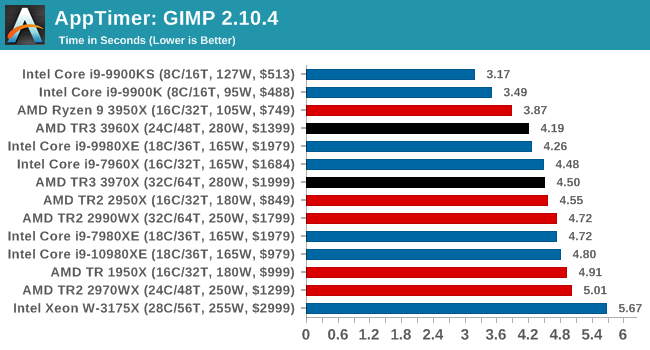
Onto our single threaded tests, and the mainstream hardware with high single thread frequencies wins here, but the 3960X is leading the rest of the pack. Intel's 28-core part here sits last, behind even the 1950X.
3D Particle Movement v2.1: Brownian Motion
Our 3DPM test is a custom built benchmark designed to simulate six different particle movement algorithms of points in a 3D space. The algorithms were developed as part of my PhD., and while ultimately perform best on a GPU, provide a good idea on how instruction streams are interpreted by different microarchitectures.
A key part of the algorithms is the random number generation – we use relatively fast generation which ends up implementing dependency chains in the code. The upgrade over the naïve first version of this code solved for false sharing in the caches, a major bottleneck. We are also looking at AVX2 and AVX512 versions of this benchmark for future reviews.
For this test, we run a stock particle set over the six algorithms for 20 seconds apiece, with 10 second pauses, and report the total rate of particle movement, in millions of operations (movements) per second. We have a non-AVX version and an AVX version, with the latter implementing AVX512 and AVX2 where possible.
3DPM v2.1 can be downloaded from our server: 3DPMv2.1.rar (13.0 MB)
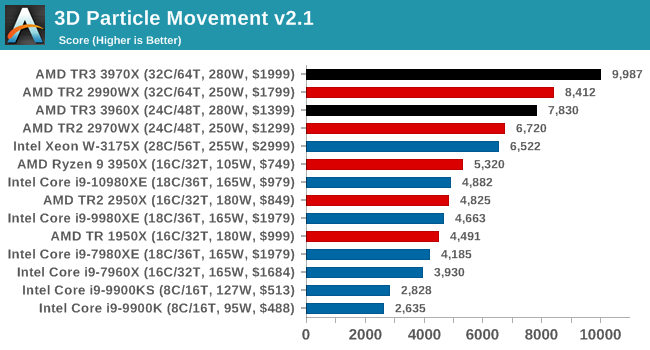
With non-AVX, AMD's floating point units put on a great performance.

This is a workload that can be AVX512 accelerated, and this is the main instance where we can see Intel's CPUs having an advantage.
Dolphin 5.0: Console Emulation
One of the popular requested tests in our suite is to do with console emulation. Being able to pick up a game from an older system and run it as expected depends on the overhead of the emulator: it takes a significantly more powerful x86 system to be able to accurately emulate an older non-x86 console, especially if code for that console was made to abuse certain physical bugs in the hardware.
For our test, we use the popular Dolphin emulation software, and run a compute project through it to determine how close to a standard console system our processors can emulate. In this test, a Nintendo Wii would take around 1050 seconds.
The latest version of Dolphin can be downloaded from https://dolphin-emu.org/
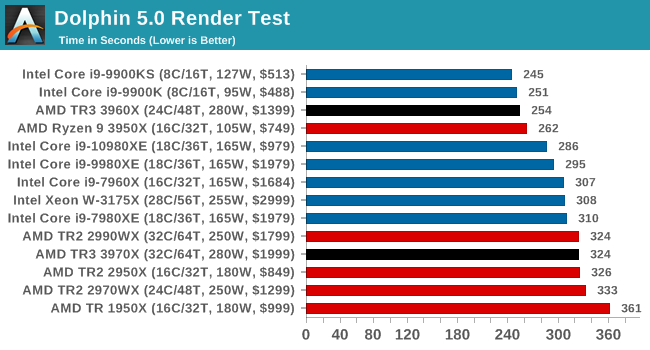
On the single threaded workloads again, and the high frequency mainstream CPUs win here. Interestingly, the 3960X also puts on a really good show, and actually beats our 3950X. Interesting.
DigiCortex 1.20: Sea Slug Brain Simulation
This benchmark was originally designed for simulation and visualization of neuron and synapse activity, as is commonly found in the brain. The software comes with a variety of benchmark modes, and we take the small benchmark which runs a 32k neuron / 1.8B synapse simulation, equivalent to a Sea Slug.
Example of a 2.1B neuron simulation
We report the results as the ability to simulate the data as a fraction of real-time, so anything above a ‘one’ is suitable for real-time work. Out of the two modes, a ‘non-firing’ mode which is DRAM heavy and a ‘firing’ mode which has CPU work, we choose the latter. Despite this, the benchmark is still affected by DRAM speed a fair amount.
DigiCortex can be downloaded from http://www.digicortex.net/
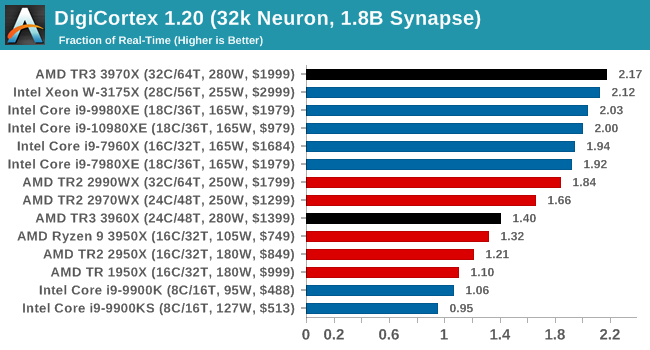
I'm surprised there's that much difference between the 3970X and 3960X here, especially with the 3960X sitting behind the TR2 processors. Might have to re-run this one to double check. But the 3970X puts out a commanding lead.
y-Cruncher v0.7.6: Microarchitecture Optimized Compute
I’ve known about y-Cruncher for a while, as a tool to help compute various mathematical constants, but it wasn’t until I began talking with its developer, Alex Yee, a researcher from NWU and now software optimization developer, that I realized that he has optimized the software like crazy to get the best performance. Naturally, any simulation that can take 20+ days can benefit from a 1% performance increase! Alex started y-cruncher as a high-school project, but it is now at a state where Alex is keeping it up to date to take advantage of the latest instruction sets before they are even made available in hardware.
For our test we run y-cruncher v0.7.6 through all the different optimized variants of the binary, single threaded and multi-threaded, including the AVX-512 optimized binaries. The test is to calculate 250m digits of Pi, and we use the single threaded and multi-threaded versions of this test.
Users can download y-cruncher from Alex’s website: http://www.numberworld.org/y-cruncher/
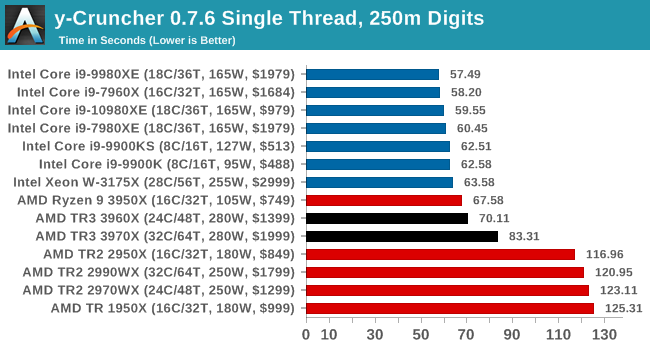
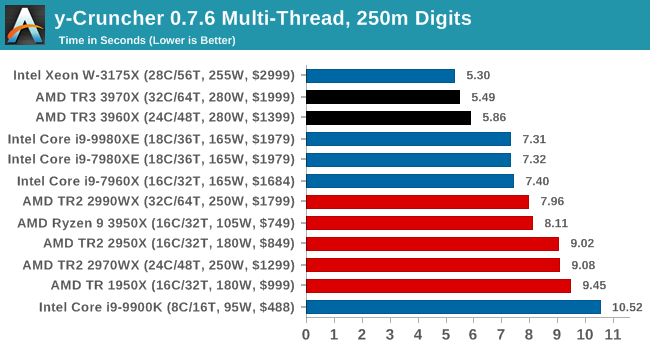
y-Cruncher is also AVX-512 accelerated, however when all the 32 threads come together in MT mode on AVX2, having that many pushes through 18 cores with AVX-512.
Agisoft Photoscan 1.3.3: 2D Image to 3D Model Conversion
One of the ISVs that we have worked with for a number of years is Agisoft, who develop software called PhotoScan that transforms a number of 2D images into a 3D model. This is an important tool in model development and archiving, and relies on a number of single threaded and multi-threaded algorithms to go from one side of the computation to the other.
In our test, we take v1.3.3 of the software with a good sized data set of 84 x 18 megapixel photos and push it through a reasonably fast variant of the algorithms, but is still more stringent than our 2017 test. We report the total time to complete the process.
Agisoft’s Photoscan website can be found here: http://www.agisoft.com/

New records for Photoscan as well.












245 Comments
View All Comments
mkaibear - Monday, November 25, 2019 - link
Intel had revenue of 19.2bn last quarter. The highest it's ever been for them.https://www.anandtech.com/show/15030/intel-announc...
Claiming that Intel is destroyed is laughable.
They're hurting at the moment, but then they were hurting in the Athlon era as well... and that didn't go so badly for them in the end.
For reference, AMDs revenue for the same period was 1.8bn. yes, Intel, despite all their problems, earned *ten times* what AMD did.
(Reference: https://www.anandtech.com/show/15045/amd-q3-fy-201...
Claiming Intel are destroyed is just fanboyism at its worst.
Xyler94 - Monday, November 25, 2019 - link
Unless Intel can get something out sooner rather than later, people are migrating to AMD because they are pushing things forward. 64 cores of Epyc fury is hitting them in the Server Space, which is where Intel is most scared of. They don't care that you or I buy an Intel chip or an AMD one, they care if Microsoft or Apple buys either or.Intel isn't destroyed, but they will be hurting for a while, as AMD is showing no signs of slowing down, and Intel has to beat what AMD makes next, not AMD today.
mkaibear - Monday, November 25, 2019 - link
Again, Intel have record earnings this last quarter. As in over the last 3 months. As in after two years of AMD kicking their backside in the server space they're still making record amounts of revenue.Intel aren't stupid, they're one of the most ruthless companies in the sector. They can throw five times as much as AMD's *total profit* in R&D and still make five times as much profit as AMD does.
Xyler94 - Monday, November 25, 2019 - link
Record breaking earnings mean nothing in the grand scheme of things.For as much as you gloat about Intel's RND, AMD is the one who's on top in 2 of the 4 markets (Laptops, Desktops, HEDT and Servers), some would argue 3. Doesn't matter how much money you can throw at a problem, it matters if you can solve it. AMD solved the problem, Intel hasn't, and it's a frantic state at Intel to make something happen, either get 10nm working better or changing their uArch in 14nm.
Right now, the only reason to consider a XEON over an Epyc would be for AVX-512 only workloads. Because otherwise, ServerTheHome has shown that Epyc dominates, especially the 7742 64 core part.
SwackandSwalls - Monday, November 25, 2019 - link
Those record breaking earnings (i.e. capital) mean a lot, and saying otherwise displays a large and intentional ignorance on how important capital is to the microprocessor industry. Intel can use that money to hire more both hardware and software talent, fund more research, build more fabs, outspend AMD in marketing, and on and on. If Intel had huge cash reserves but was putting up large losses every quarter then I'd be on board with your "grand scheme of things" comment. In reality they are massively profitable, selling more 14nm chips than they can produce, and have enough cash to not only learn from AMD's successes but also invest in following suit.Xyler94 - Monday, November 25, 2019 - link
Again, Hire all you want, throw as much money as you want. That doesn't matter if there's no results.AMD with literally tenths of Intel's funding can beat them, and have found better ways to make processors to increase core counts without sacrificing efficiency. Intel also needs to spend a lot of money on researching the node itself, AMD doesn't, so not all of Intel's RnD goes to making the CPU, lots of it goes into making the node itself.
So while Intel may make more, they have to spend way more, especially since CPUs aren't the only thing Intel makes (They make flash chips, 3D XPoint, Networking chipsets, and many other products, all vying for that sweet RND cash)
So while Intel makes more, they also spend more. Revenue is a great figure to look at on paper, but it doesn't amount to anything unless the spending is done wisely. AMD surely has shown that it doesn't take Intel levels of cash to become a market leader and capitalize on someone who's grown complacent.
milkywayer - Monday, November 25, 2019 - link
"record breaking numbers mean a lot".So what happened then, why is AMDs offering more power and cost efficient at a much much lower price?
Korguz - Monday, November 25, 2019 - link
mkaibear/SwackandSwalls, and point is ?? intel has all that money, yet.. been milking the SAME architecture for how many years ? as Xyler94 already said.. to keep throwing money at a problem, and it STILL doesnt get fixed, is NOT a good thing. AMD may not have the money that your beloved intel does, but guess what, they have been able to do MORE with what they do have, so tell me who is spending wiser ?? also.. how much of that 19.2 billion has intel had to dump into their fabs??imaheadcase - Monday, November 25, 2019 - link
I really hope you are not comparing Intell vs amd based on a just a CPU..that is illogical.TEAMSWITCHER - Monday, November 25, 2019 - link
Intel isn't "hurting" now... Desktop processors are not what most people want.